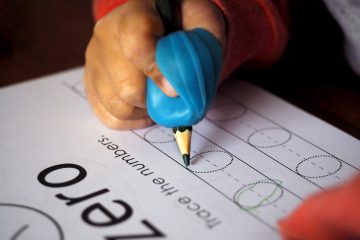 Most parents of preschoolers and kindergarteners have starting thinking about how they can help their children get ready to read. Hopefully by the time your child is 3 or 4 years old, he has had plenty of exposure to books, nursery rhymes, songs, and the letters of the alphabet. Take a look at my last post, Literacy Activities: Toddler to Preschool, if your child has not yet had these experiences.
Most parents of preschoolers and kindergarteners have starting thinking about how they can help their children get ready to read. Hopefully by the time your child is 3 or 4 years old, he has had plenty of exposure to books, nursery rhymes, songs, and the letters of the alphabet. Take a look at my last post, Literacy Activities: Toddler to Preschool, if your child has not yet had these experiences.
As your child becomes more comfortable with the sounds that letters make, you can begin to help her connect the letter-sounds into words. Many of the easiest beginning words are CVC words (consonant-vowel-consonant words). Examples are “mat,” “big,” “get” –all are phonetically regular, short CVC words that contain phonemes (sounds) that are easy to identify. To give your child practice with CVC words, you can:
- Buy or make CVC word puzzles: Find a commercially produced product, or simply create your own puzzle by writing out a CVC word and then dividing it into separate letters. Puzzles that include a picture of the word can help children connect the word and the letters to meaning. Click here to see letters put on Duplo building blocks to spell out words.
- Buy or make CVC flipbooks: Again, commercially produced products are available, but you can also make your own. Simply write out the last two letters of a CVC word –for example, “-at,” and then add a stack of letters at the front of the word, for example “m,” “b,” “c,” “r.” Your child can then practice creating different words by keeping the “-at” sound at the end of the word the same, and varying the beginning sounds to form the words “mat,” “bat,” “cat,” and “rat.”
- Look at words within “word families”: Read books to your child or introduce him to videos that focus on a particular word family, for example words that end in “-an” or “-ad.”
- Look at words within the context of rhymes: Introduce your child to books and materials that focus on rhymes. As with word families, rhymes help children hear the phonetic connections between words with similar spellings and sounds.
- Introduce a letter wall: Designate a spot in your home–perhaps the refrigerator door, or a bulletin board–and make it into a letter wall. Place magnetic or adhesive letters on the wall and let your child create her own CVC words by moving the letters around.
- Introduce writing games: If your child has begun to write some letters, you can begin to offer him practice with encoding (using knowledge of letters and letter sounds to write words). Play guessing games, for example, asking him to write the letter that comes at the beginning of the word “bed.”
- Find fun and easy ideas online: If you use Pinterest, there are numerous ideas being shared by teachers and parents. Just type “word puzzles,” “CVC,” “word building,” or “word families” into the search field and you’ll be greatly rewarded with ideas.
As your child’s developing reading skills continue to grow, you can expand these activities to include more advanced objectives. You can use many of the same resources as before–flash cards, online activities, puzzles–but expand the material to include new and more complex aspects of phonological awareness:
- Digraph and blend activities: Digraphs are two or more letters grouped together but making a single sound, for example “th” and “ch.” Blends are two or more consonants grouped together but making separate sounds, for example “br” and “gl.” You can give your child practice with recognizing digraphs and blends through activities with flashcards, puzzles, online games and media, and by pointing them out in text.
- Rhyming games: Increase your child’s familiarity with rhymes by having her write poems, play matching games with rhyming words, and come up with new or unusual rhymes.
- Blending and substitution games: Once a child can comfortably blend the letters “c” “a” “t” into “cat,” you can expand to more complicated words. For example, you can give him the letters “f” “r” “o” “g” and let him practice blending those letters into a word. You can also introduce substitution activities, for example asking, “What happens when you take away the ‘r’ in “frog?”
- Phoneme isolation games: Give your child practice with hearing sounds within words. For example, you can go on a “sound hunt” around the home, finding all of the objects that have the /s/ sound in them (stove, soap). To make the game more challenging, you can look for objects that have the same vowel sound in them (s/i/nk, refr/i/gerator).
- Segmenting activities: Working in the opposite direction as the blending activities, you can have your child start with a whole word, such as “block,” and break it into pieces. You can use the pieces to make a puzzle, or a flipbook with “-ock” at the end, or create a list of rhyming words (sock, rock, dock).
All of these activities will help ensure your child is getting the best possible literacy development he can get. Before you know it, she will be reading the bedtime stories to you!
Do you have any ideas we didn’t mention? Feel free to add them in the comments section.


